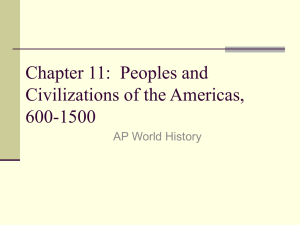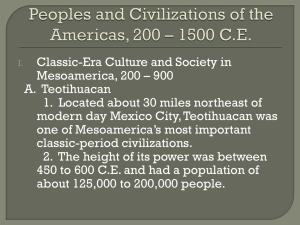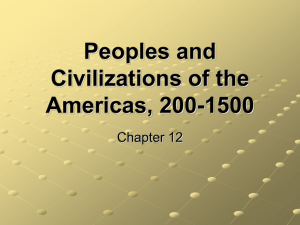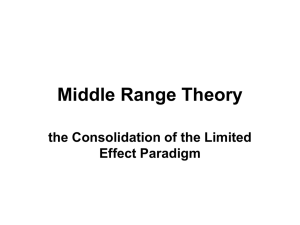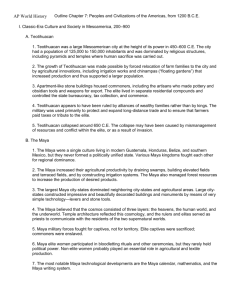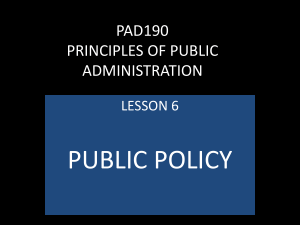Ch 11
advertisement
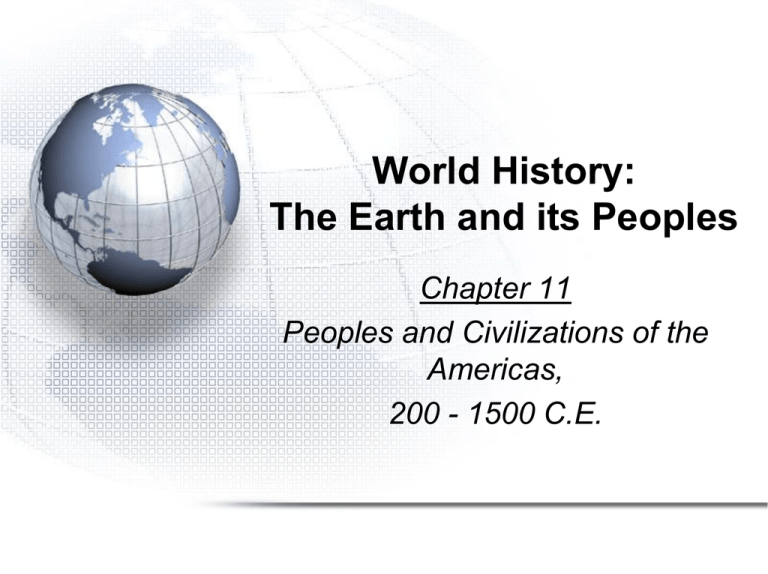
World History: The Earth and its Peoples Chapter 11 Peoples and Civilizations of the Americas, 200 - 1500 C.E. Objectives • How did differing environments influence the development of Mesoamerican, Andean, and northern people? • What technologies were developed to meet the challenges of these environments? • How were the civilizations of Mesoamerica and the Andean region similar? How did they differ? • How did religious belief and practice influence political life in the ancient Americas? Classic-Era Culture and Society, 200-900 Classic Period - (200-900 CE) – Olmec traditions – platform and pyramid structures • political and cultural innovations – elite ability to control laborers – rich and power of leaders Teotihuacan - (450-600 CE) – largest city in Americas • 125,000 to 200,000 – pyramids to Sun and Moon gods • human sacrifice – well-being of society – Quetzalcoatl • feathered serpent god Classic-Era Culture and Society, 200-900 Teotihuacan Agriculture – marginal lands into production – chinampas • “floating gardens” • year-round farming Commoner Housing – apartment-like stone buildings – artisans Commerce – base of wealth for elite class Politics – alliance of elite families – demise to invaders or interior elite / class conflict The Maya Maya – Guatemala, Belize, Honduras – tropical climate and fragile soils • managed forests; terracing • draining swamps; gardens – single culture, no political unity • city-states – centered of religious temples • awe the masses • pyramids and plazas • alignment with Sun and Venus • rulers – priestly and political – bloodletting as communication The Maya Military – captives not territory • elite warriors sacrificed Women – ruling class • important roles in ceremonies • bloodletting – common • gardens; family, religion, healing Technology – calendric system • ritual, solar, cycle, long count – math • zero and place value Postclassic Period, 900-1500 Population expansion – intensified agriculture – increased warfare Toltecs - 968-1156 CE – Tula – important innovations • military and political • conquest state – warrior, sacrifice images – downfall • division of responsibility • struggle between religious cults • new Mesoamerican order – urbanized Toltec statecraft The Aztecs Aztecs - 1325 – Mexica – clan-based from N. Mexico • serfs and mercenaries • adopt Toltec urbanization – Tenochtitlan and Tlatelolco • Lake Texcoco • shift to monarch system – rulers selected by council – war provided legitimacy – social reorganization (inequality) • warrior elite – slaves and serfs • clothes, diets, marriage Aztecs Population – 150,000 (500,000 by 1500 CE) • Agriculture – labor of clans and defeated – land reclamation • Lake Texcoco dike – chinampas • maize, fruits, vegetables – tribute system • 1/4 of crops • Commerce – specialized merchant class – no money or credit (barter) – Tenochtitlan markets Aztecs Religion – polytheistic; dual nature gods • male and female • war and agriculture (Twin Temples) – Huitzilopochtli • cult of the hummingbird • Sun’s warmth – human hearts – Tlatoc • rain god • human sacrifice – war captives – criminals, slaves, tribute – political subtext Sacrificial Tools Northern Peoples ^ Agriculture = ^ Population – maize, beans, squash – irrigation systems Southwestern Cultures – Mexican influence • Anasazi - 450-1200 CE – “ancient ones” – four-corner region – underground buildings (kivas) • artisan activities Decline – population pressures – limited arable land in drought Mound Builders Adena - 500 BCE – Ohio River Valley – monumental earthworks • elite burial mounds Hopewell - 100-400 CE – hunter-gatherer / limited agriculture – chiefdom • hereditary • religious and secular Cahokia – Mississippi Valley – East St. Louis – 30,000 population Andean Civilizations, 200-1500 Andean Society – effective organization of labor • khipus – census and tribute counts • terrace farming – ayllu (clan) • communally held land • reciprocal relationship – mit’a (territorial state) • state projects • vertical integration – small ecological areas – access to essential zones Moche Moche - 200 CE – city-state • influence via military • theocratic society – massive irrigation • coca for religious rituals – llamas and alpacas • artisanship – pottery: textiles – gold and silver objects: metal tools • decline – natural disasters – rise of new military powers (Wari) Tiwanaku and Wari Tiwanaku – Andean highland (13,000’) – Lake Titicaca reclamations – ceremonial / political center • large regional population Wari – possible twin capital or dependency – lacks central planning Decline increased military conflict The Inca Inca – ambitious military expansion • resources from ecological zones • llamas and alpacas – collective efforts • 1/7 male population – held hostage • local ruler heirs held in Cuzco – Cuzco • Incan capital • shape of a Puma • Weakening – civil war in 1525

